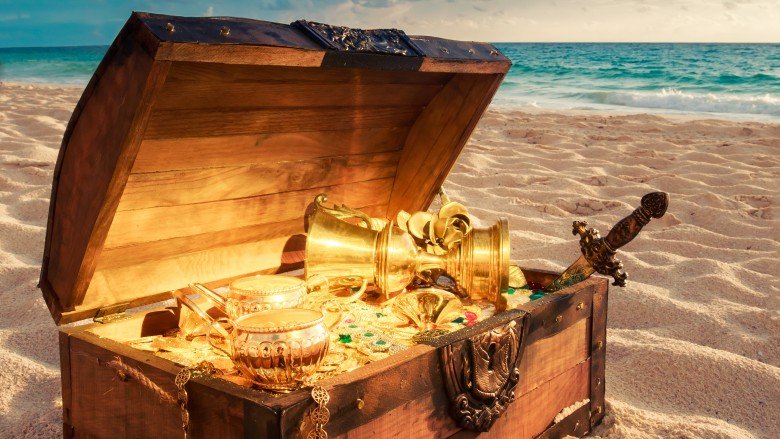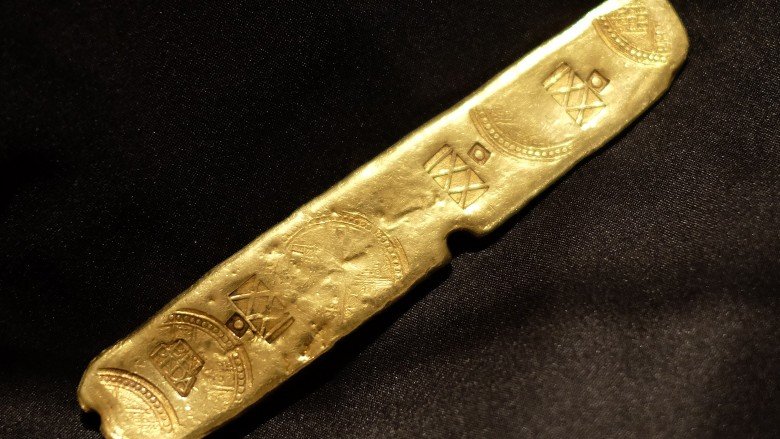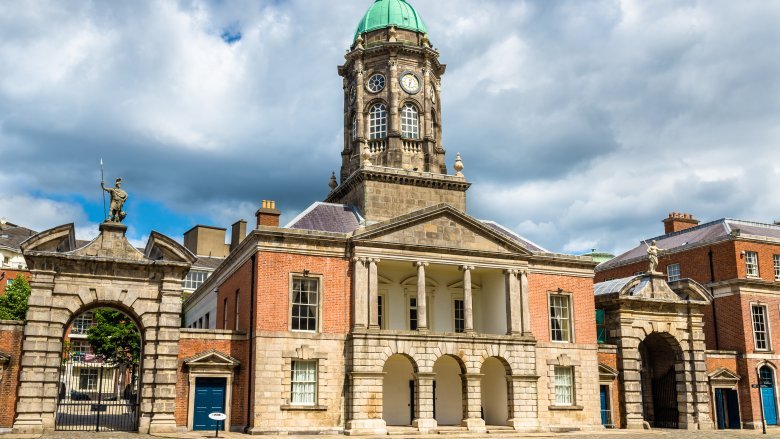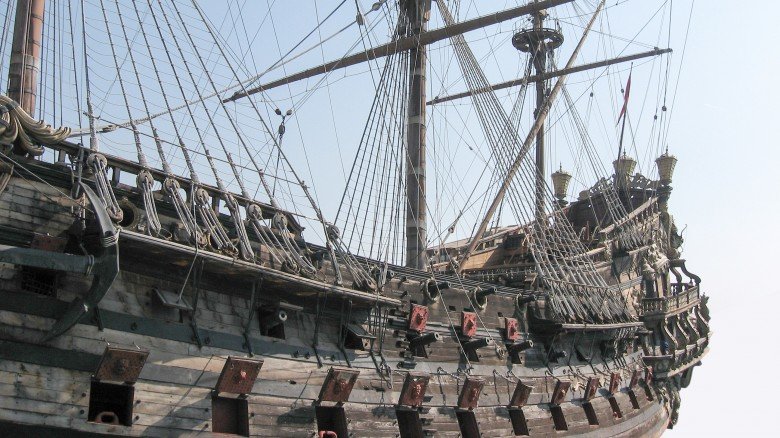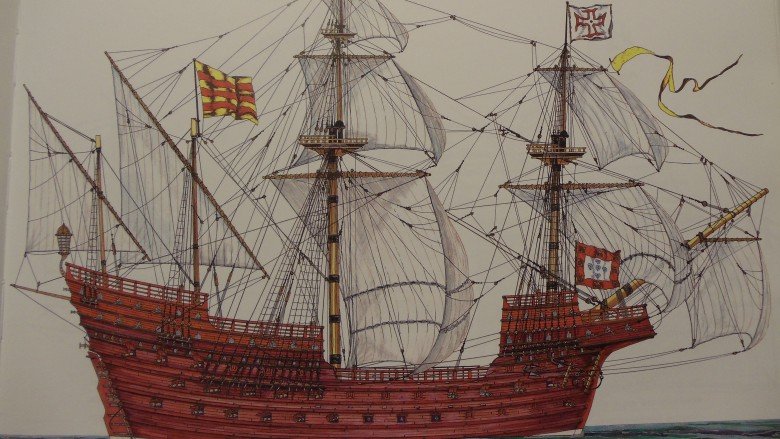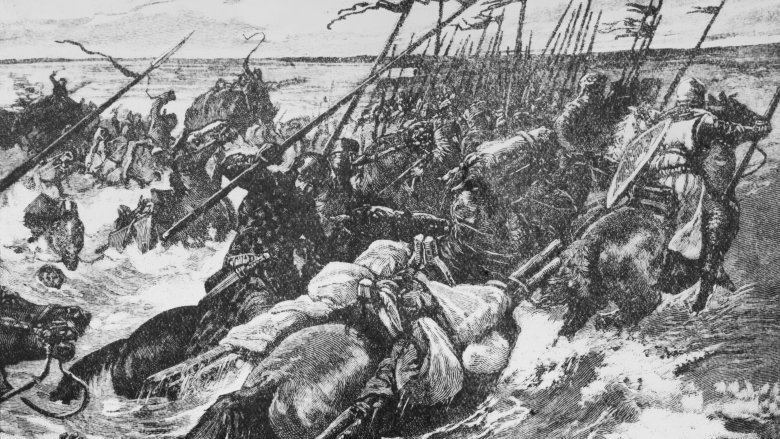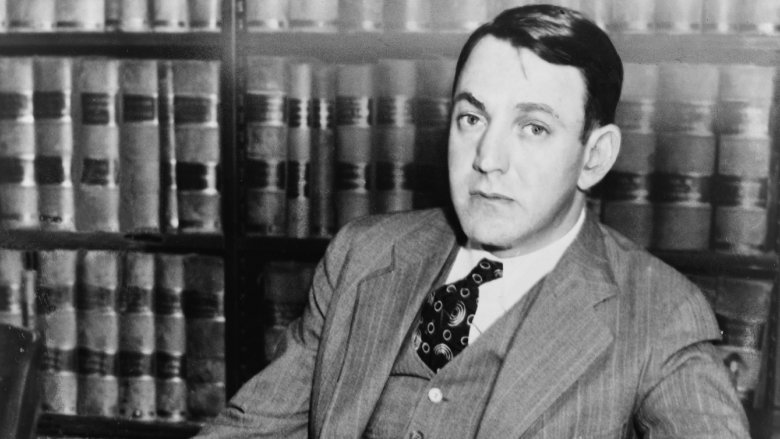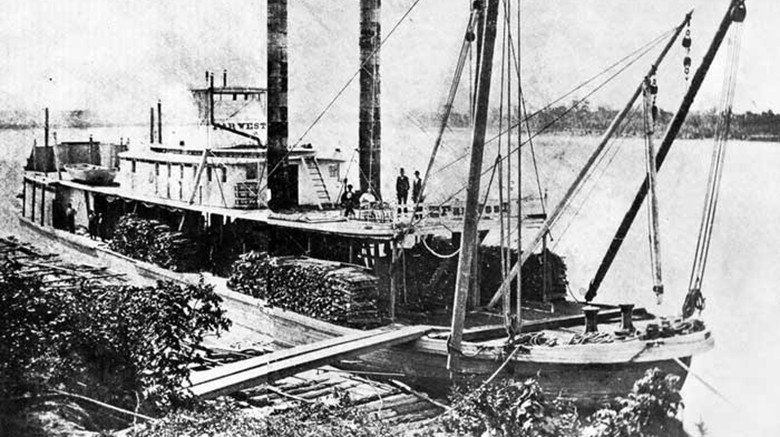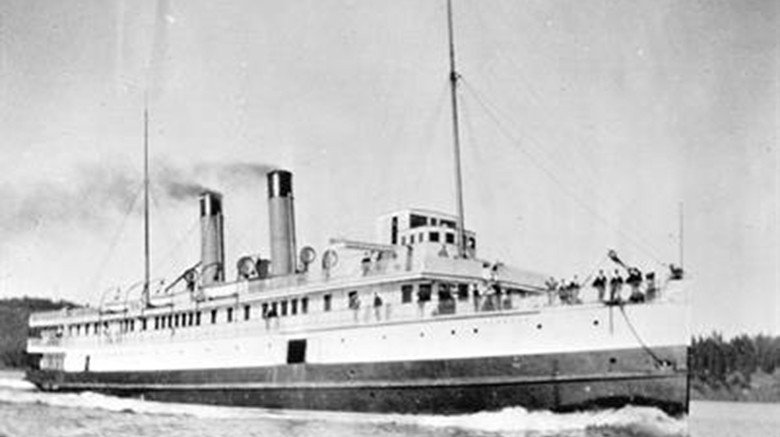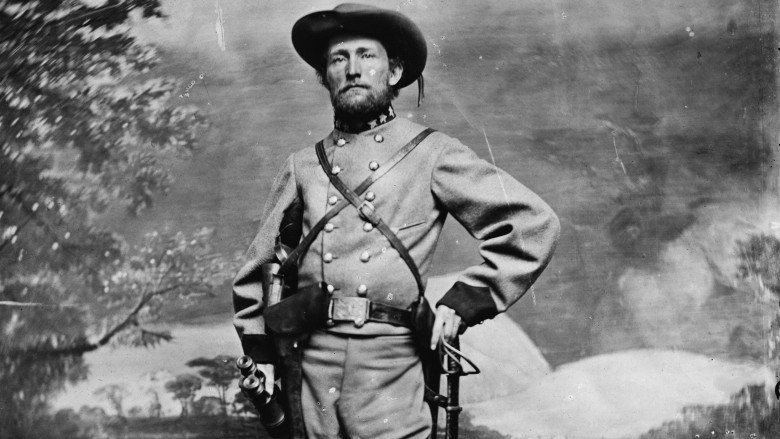Real Hidden Treasures Still Waiting To Be Found
We've all imagined stumbling upon treasures of unimaginable wealth — it's why we have lotteries, after all. Of course, by now, all the really good treasure must all have been recovered, right? Wrong — billions of dollars of bountiful booty are still out there, just waiting for the right adventurer to track them down and turn them into a retirement plan for the next ten generations of their family. Grab your pickaxe, shovel, and diving gear, and get to work on unearthing ...
Captain Kidd's treasure
Anyone who says they don't want to be a pirate is lying at least a little bit, but since it isn't a great career choice, finding a pirate's treasure is a completely legitimate alternative. Captain William Kidd was one of the Indian Ocean's most notorious pirates, and when he was executed in London in 1701, he took his secrets to the grave.
That includes the location of his flagship and the treasure that he amassed during his career. If you care to go looking for the Adventure, the ship is somewhere around Madagascar and the island affectionately named the Island of the Pirates, Sainte Marie. According to the accepted story, Kidd set Adventure on fire and buried her in a watery grave, transferring what booty he could carry onto a new ship. But then it gets murky; legend relayed by the Washington Post says it's buried either off the coast of Madagascar, in New York, or in the Caribbean.
In 2015, Barry Clifford declared he'd found the wreck of Adventure, and he had a 110-pound silver ingot as proof. But no worries, dear treasure hunters. UNESCO declared it wasn't treasure at all, just a piece of lead ballast. It — and other historians — condemned Clifford's shoddy excavation and lack of documentation, and confirmed that Captain Kidd's treasure is still up for grabs.
The Amber Room
It was so impressive that it was called the Eighth Wonder of the World, and just like they ruined the swastika, the Nazis ruined this. According to the Smithsonian, Nazis looted the Amber Room of St. Petersburg's Catherine Palace, packed it into 27 crates, and sent it to what's now Kaliningrad. It was actually reassembled there as part of a castle museum for two years. In 1943, the Amber Room was broken down into pieces yet again and hidden from the approaching Allied forces.
And that's all we know. There are plenty of theories about its ultimate fate, including the possibility it was destroyed by bombings. But other theories say it's still kicking around, possibly at the bottom of the Baltic Sea or scattered throughout private collections. One of the Amber Room's panels was actually found in Bremen in 1997, but it was being sold by the son of a soldier who had no other information. There's even a theory that says the Amber Room the Germans stole was a fake one and that the real one has been missing for a heck of a lot longer than we think. Either way, if you're wondering how six tons of amber goes missing ... join the club.
Treasure of the Nuestra Senora de Atocha (Captain's Cabin)
Yes, the good ship Atocha was found and salvaged in 1985, from what the press called "The shipwreck of the century." However, the most valuable part — the stern castle that housed the captain's cabin and the ship's most valuable cargo — has yet to be found.
The Nuestra Senora de Atocha was part of a Spanish flotilla of 20 ships bound from Havana to Spain in September of 1622. The ships were carrying an incredibly large amount of precious metals and valuable goods. The day after they set sail, a hurricane sank eight of the 20 ships, including the Atocha, which acted as the rear guard for the flotilla. The vessel was a heavily armed galleon, and held one of the largest caches of treasure in the whole fleet. Since the ship sank in only 55 feet of water, attempts were quickly made to recover the horde, but the Spanish salvage teams couldn't open the hatches. A month later, another hurricane swept the wreck away, leaving it lost for more than 400 years.
The treasure that has been recovered consists of nearly $500 million worth of precious metals and artifacts, but the elusive captain's cabin remains to be found. Any salvage expert or true adventurer who finds and recovers it will truly be set for life.
The Irish Crown Jewels
Many things were different in 1907, and ideas about security were very different. When the Irish Crown Jewels went missing, they were under the not-so-watchful eye of Sir Arthur Vicars, who kept them in the library of the Bedford Tower of Dublin Castle. They were only kept there because no one had measured the door when they were building the dedicated safe room. The jewels' actual safe couldn't fit, so they decided to just leave them in the library and, presumably, go for a drink.
It was a member of the cleaning staff who told Vicars the keys to the library door weren't where they were supposed to be on the morning of July 6. It wasn't until the afternoon that he bothered to check the jewels and found they were gone. Locks were unlocked, doors had been opened, and no alarms had been sounded, leading to the belief that it was an inside job. The top suspect isn't Vicars but his second-in-command, Francis (brother of Ernest) Shackleton. He ultimately vanished without a trace after completing a prison sentence for bank fraud. Other suspects have been named, but the jewels are still missing. The Irish would probably still like them back, please and thank you.
Treasure of Santissima Concepcion
The Santissima Concepcion — known at the time as El Grande — was a massive Spanish galleon commanded by Admiral Manual Ortiz Aosemena when it sank in 1683. The El Grande was carrying a treasure bound for Spain, when it ran into the hurricane that sank it and killed 496 on board. Only four men made it to the shores of Saint Augustine, Florida, but the ship and its treasure was never found.
The El Grande was said to be carrying silver bullion, spices, 1,500 pounds of gold, 77 chests of pearls, 217 chests of other goods, and 49 chests of emeralds. Legend has it that only a single chest filled with clothes and 1,500 pesos washed ashore in Florida — it was believed to belong to the wreck, but nothing has ever been found since. Recovery efforts went on until around 1701, but the wreck's location is currently unknown. It may be somewhere in the waters of Key Biscayne or anywhere between the Florida coast and the Bahamas.
Treasure of San Miguel
A lot of the treasure lost at sea during the early years of the eighteenth century cam about due to two things: the War of Succession in Spain, and a whole slew of hurricanes. In 1715, a small flotilla of ships came together to form a fleet of treasure ships, bound from the New World to Spain. Spain was in dire need of funds following the war, so it was common for treasure ships to sail back to Europe during times of peace, so they could help build up the empire's coffers.
The flotilla arranged in 1715 was another of these missions, and they decided to hold off on their trip until right before hurricane season began, the idea being that the prevalence of hurricanes might keep pirates away during their trip. The wager paid off, in that they didn't have to deal with pirates, but then the hurricane went after them, sinking every ship in the fleet.
Since the fleet sank, many efforts have been made to recover the treasure. Only a small fraction of the treasure was ever found, but six of the seven vessels were located. The San Miguel was a small Carrack-class vessel, lighter than a galleon and therefore faster. Because of this, the San Miguel was loaded with treasure, one of the richest treasures to be found on the bottom of the sea, in fact. So naturally, it's the one ship in the fleet nobody's found. There's always a catch.
King John's Crown Jewels and treasure
England's King John just can't catch a break. He's immortalized as the king that gave away the power of the monarchy when he signed the Magna Carta, and he's the bad guy in every Robin Hood movie ever made. He also managed to lose not just the country's Crown Jewels, but a massive amount of treasure, too.
It happened about a year after he signed the Magna Carta, and according to The Daily Beast, he and his men were heading from King's Lynn to Lincoln when something happened. There are a few different versions of the story, and they were either going to or coming from trying to subdue one of the many rebellions popping up across the country. The retinue's baggage train ended up getting trapped in the boggy swamps near Long Sutton. The area flooded, killing countless men and washing away the Crown Jewels and the other treasures they were carrying.
The search for John's jewels isn't over, and the BBC says recent advances in technology have allowed archaeologists to map changes in the landscape over the centuries, and hopefully help decipher a bit more about what happened that day. When software will tell us exactly where the treasure finally came to rest, be sure to share that Kickstarter link. Thanks.
Treasure of Genghis Kahn
It may surprise you to learn that the final resting place of history's most successful emperor, who commanded the largest contiguous empire in history, is unknown. The grave of Genghis Khan has been a secret lost for nearly a millennia — wherever it is, it's likely the untold riches of the Mongolian Empire might just be settled there, too.
That's the basic legend of Khan's tomb. The story goes that he wished his burial place be kept secret, so 40 of his men took his body and buried it somewhere. They were then killed by Khan's guards, who in turn committed suicide, leaving nobody alive to tell where the tomb was. It is also said that "40 girls — adorned in precious garments, gold and fine jewels — were killed and buried with him, to join his spirit in the afterlife." Whether or not this story is true doesn't matter. The location of Khan's final resting place has been a mystery since his death, and people have been looking for it ever since.
Many believe that Khan rests somewhere around Laky Issyk Kul in Kyrgyzstan, but that's as far as anyone has ever gotten. The Soviets took this legend so seriously, they funded a costly expedition in the 1970s to search for the tomb, but found nothing. There are also those who believe he may have been buried atop Mount Burkhan Khaldun in Mongolia, as this would have been one of the highest points in the empire, and thus quite the symbolic place to bury its leader.
When it comes to buried treasure, finding the tomb of Genghis Khan — even without a speck of gold, though many specks would be preferable — would still amount to the discovery of the century. That's something every treasure hunter would love to put on their business card.
Treasure of Lima
It's one of life's most fundamental truths: most people just can't be trusted to not steal a treasure hoard when they're hired to transport it for someone else. That's exactly what happened in 1820, when Captain William Thompson was given the care of a cargo hold full of reclaimed pirate treasure, including things like 1,000 diamonds, 200 jewel-filled chests, and 113 gold statues. Thompson was a British trader hired to take the treasure from Peru to Mexico. Instead, predictably, he took it for himself. It's believed he headed to Cocos Island in the Pacific, stashed the treasure, then set sail again. Unfortunately for Thompson, he ran into the Spanish, who executed the entire crew except for Thompson and his first mate. They bargained with their captors, promising to lead them to the treasure. We already know Thompson's word wasn't really worth much, so it's not surprising that he escaped into the Cocos jungles when they returned.
No one's really sure what happened to them after that, but it's thought they were rescued sans treasure. Thompson isn't the only one said to have buried treasure there. A British sailor supposedly left 350 tons of gold there, along with the ill-gotten gains of the pirate Benito Bonito. No one's really been able to do much large-scale searching, as treasure hunting has been outlawed by Costa Rica on behalf of UNESCO, the party-poopers.
Dutch Schultz's fortune
Dutch Schultz was a Prohibition-era gangster who spent the 1920s supplying New Yorkers with all kinds of alcoholic goodness. Like many of the bootleggers and gangsters that grabbed a piece of the Prohibition pie, Schultz fell afoul of the law. After he was acquitted for the second time, he knew he needed to move his fortune somewhere safe. He sent his bodyguard, Bernard Rosencrantz, into the Catskills with a treasure worth somewhere between $5 million and $9 million. No one is really sure just how much is hidden out in the mountains or what it even is, but we know that it's out there.
Schultz and his men were taken out in 1935, after a rival gang decided they'd had enough of the competition. Schultz survived the immediate attack, and while he was dying in the hospital he incoherently raved about a treasure hidden in the woods. The only other person who knew where the treasure was — Rosencrantz himself — died in the same hail of bullets. It's thought Rosencrantz buried his boss's treasure somewhere near Esopus Creek, but there are so many versions of the legend that it's hard to tell. Some suggest the treasure was buried between two pine trees, while others think it's near a rock called Devil's Face. Clues are vague, but on the plus side, the Catskills are beautiful, and there are worse places to hunt for treasure.
Treasure of the Far West
At the Battle of Little Bighorn, General Custer had his last stand against a mixed camp of Lakota, Cheyenne, and Arapaho Indians. Custer engaged the camp knowing it was massive and, as we all know, he lost big time.
You might be wondering what this has to do with lost treasure. Here's how: the Far West steamboat was sailing up the Bighorn River, captained by Grant Marsh. His mission was to rendezvous with troops commanded by General Alfred Terry, and resupply his men. Before Marsh could reach his destination, however, word of the Custer massacre reached the steamboat, and it was diverted so it could carry the wounded to Fort Lincoln near Bismarck.
There are conflicting stories as to why the Far West was carrying gold valued at around $375,000, but the reason why it had to alleviate itself of the heavy load is fairly clear. The weight of the gold, plus the weight of 51 wounded men and additional firewood to make the journey to Fort Lincoln, made the Far West an easy target. The treasure had to go. Marsh buried it somewhere along the shore of the river, with every intention of later retrieving it. Unfortunately, as the story goes, Marsh did later return to the exact spot he buried the treasure, but a mudslide had washed it all away. Efforts to recover the gold stash failed to recover a single bar, which leaves a considerable horde of gold buried somewhere along the Bighorn River, just waiting to be found.
Treasure of SS Islander
The SS Islander was a ferry operating in the waters of Alaska at the height of the Klondike Gold Rush in the late 1890s. The ferry was carrying 180 people on August 14th, 1901, when it struck either a rock or iceberg between Douglas and Admiralty Islands. The ship sank within twenty minutes, and 40 people went down with it. In addition, it's believed that the ship contained a great deal of wealth when it went down. Rumors insist there were hundreds of thousands of dollars, plus just tons and tons of gold. Low estimates suggest about $3 million in gold, but upper estimates put the modern value closer to $260 million. So you can see why people wanted to find it, and fast.
The wreck was finally located in 1921 at a depth of 300 feet, which was too deep for diving technology at the time. An effort was made to raise the ship and bring it to shore in 1934. They succeeded in dragging the wreck from the bottom of the sea, but failed to recover the expected cache of gold. Since then, only 1,000 ounces of gold have been recovered from the site. What's more, there has been a legal battle over salvage rights of the wreck, as the belief remains that a huge amount of gold is awaiting whoever can dredge it up to the surface.
Interested? Well, you might have to get in line to give it a shot. Ocean Mar and MK Salvage Venture are actively attempting to recover the gold once and for all, and we're guessing they don't like competition.
Treasure of Colonel John S. Mosby
Virginian Confederate Colonel John S. Mosby was a notorious guerilla fighter known as the Gray Ghost. He and his men captured 42 Union soldiers at the Fairfax County Courthouse one evening, without even having to fire a single shot. Those Union soldiers had a huge booty of plundered goods, which they had taken from the most affluent of Virginia's plantations. Among the collection were family heirlooms, jewelry, candlesticks, coins, and other valuables within a large burlap sack. Colonel Mosby took the goods and the men he captured, and headed back to friendlier territory behind Confederate lines.
Before he could move his men through enemy-occupied territory, however, his scouts reported a large contingent of Union soldiers waiting to ambush them. Fearing a loss of his newly-discovered treasure, he and a trusted officer went into the woods and buried it between two pine trees he marked with an X. Colonel Mosby planned to return and claim the treasure when he could, but was unable to make it. He sent seven of his men to recover it, but they were captured and hanged by the enemy.
This left Colonel Mosby as the only remaining person who knew the location of the treasure, but he died before he could ever recover it. It's been estimated that this treasure is worth around $350,000 and it's been sitting somewhere in the woods of Fairfax, just waiting to be dug up for more than 150 years. Maybe don't expect the candlesticks to have survived.
Treasure of Thomas Beale
In 1885, a pamphlet was published describing the story of Thomas J. Beale, and a great treasure awaiting anyone who could find it in the hills of Bedford County, Virginia. The pamphlet explained that Beale claimed to have found a treasure consisting of great wealth in a cave sometime in the 1820s. He worked with 30 friends to remove the treasure of gems, gold, and silver from the cave to an undisclosed location in Bedford County, where they buried it. Seems like a weird thing to do instead of, you know, spending it, but OK.
Beale then wrote down three ciphers, which he placed into a box and gave to Robert Morriss, a trusted friend and innkeeper of the local tavern. One cipher contained the location, the other a description, and the third listed the names of everyone involved. Morriss was instructed not to open the box unless he hadn't heard from Beale or his partners within a decade. Beale was never seen or heard from again.
When the required time had passed, Morriss opened the box and began working to decipher the texts. He never succeeded, having spent decades on the task. When he died, he bequeathed the papers to an unnamed friend who, in turn, attempted to crack the code. This unnamed man was actually able to break the encryption of one of the three ciphers, using a copy of the Declaration of Independence. The code he cracked provided a detailed description of the treasure — unfortunately finding this treasure proved futile, as the remaining two texts remained undeciphered. Finally succumbing to failure, the man published a pamphlet titled "The Beale Papers" through a friend named James B. Ward, who sold them in 1885 for $0.50 each. Ever since the pamphlet was published, eager treasure hunters have dug holes all over Bedford County, but to no avail. Probably because nobody's thought to consult the world's top expert of the Declaration of Independence, Nicolas Cage.
Forrest Fenn's treasure
In 1988, Vietnam veteran and treasure hunter Forrest Fenn got some heartbreaking news. He was diagnosed with cancer, and the prognosis wasn't good. He prepared to die, taking a small chest and filling it with his most precious possessions. According to Vox, he was going to head up into the mountains and die with his treasure. He beat the cancer but kept the chest, and in 2010 he buried it somewhere in the Rocky Mountains. Then, he published nine clues in the form of a 24-line poem, promising whoever found his treasure would score a haul worth millions.
It's not surprising that a ton of people have looked for the treasure, and Fenn estimates that somewhere around 65,000 people have headed out to the Rocky Mountain wilderness, armed with a theory that's just gotta be right. No one's been right yet, but the hunt hasn't come without its cost. Even though Fenn keeps reminding people that the treasure is hidden in a place that's accessible by his 80-year-old self, several people have died in the quest. The Telegraph repeated a warning issued by the local police departments who found the remains of the ill-fated treasure hunters, calling it dangerous nonsense. Nonsense or an MMORPG quest come true?
Update: Forrest Fenn announced in June 2020 that his treasure had been found. According to CNN, an explorer who wanted to remain anonymous sent photos of the treasure and its hiding place to Fenn. Fenn said he hopes people will continue to be drawn to exploring the outdoors.
